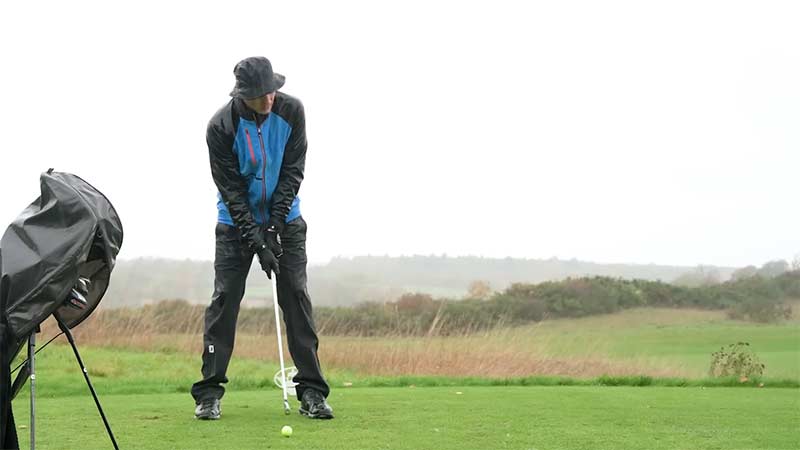In the serene world of golf, the whims of the wind can transform a tranquil day on the course into a formidable challenge for even the most seasoned players. The term “windy golf day” encompasses more than just a gentle breeze rustling through the fairways.
It entails a complex interplay of atmospheric factors that significantly influence the game. As golfers prepare to tee off, they must grapple with varying wind speeds, directions, and gusts that can alter the trajectory of their shots and demand a recalibration of strategy.
In this exploration, we delve into the nuances of what is considered a windy golf day, unraveling the intricacies that turn a leisurely round into a test of skill, adaptability, and strategic prowess.
Join us as we navigate the gusty landscape of golf and uncover the secrets behind mastering the art of play when the wind becomes a formidable adversary.
What Is Considered a Windy Golf Day?
A windy golf day is more than a meteorological condition; it’s a transformative force that demands a unique set of skills and strategies. Let’s delve into the intricacies of what constitutes a windy golf day.
Wind Speed and Its Impact
The velocity of the wind is a crucial factor that determines the challenge level on the golf course. A mild breeze may subtly influence the ball’s trajectory, requiring adjustments in aim and distance calculations.
However, as wind speed intensifies, so does the complexity of the game. Understanding the correlation between wind speed and shot precision becomes pivotal for golfers facing varying degrees of challenge.
Wind Direction: The Game-Changer
The direction from which the wind blows significantly alters the game dynamics. A headwind, opposing the direction of play, demands increased power and precision.
On the other hand, a tailwind, pushing the ball forward, necessitates careful consideration of overshooting. Crosswinds introduce a lateral element, compelling players to adjust their shots to counter the wind’s influence.
The strategic adaptation to different wind directions becomes an art in itself, distinguishing skilled golfers from the rest.
Gusts and Unpredictability
Gusts, sudden bursts of wind, inject an element of unpredictability into the game. Golfers must contend with the challenge of timing their shots amidst these intermittent forces.
Anticipating and adapting to gusts require heightened awareness and split-second decision-making. It’s not merely a test of skill but a mental game where resilience and quick thinking play a pivotal role.
Impact on Ball Flight
The wind’s influence on the trajectory of the golf ball is a constant puzzle for players. Understanding how wind affects different types of shots – drives, approaches, and putts – is essential.
Tailwinds can add distance but may alter the landing spot, while headwinds can reduce the ball’s travel distance. Golfers must hone their ability to read the wind’s impact on their shots, adjusting techniques accordingly for optimal results.
Strategies for Windy Conditions
Successfully navigating a windy golf day involves more than adapting to the elements; it requires a strategic approach. Golfers often modify their club selection, opting for lower-lofted clubs to keep the ball closer to the ground and reduce the impact of the wind.
Additionally, altering the swing technique to achieve a lower ball flight can mitigate the wind’s influence. Mastery in windy conditions involves a blend of technical adjustments and strategic decision-making, elevating the game to a new level of complexity.
Mental Resilience: A Key Component
Windy conditions not only challenge a golfer’s physical skills but also test their mental resilience. Frustration can easily set in as meticulously planned shots veer off course due to the wind’s capricious nature.
Successful golfers in windy conditions exhibit composure, adaptability, and the ability to stay focused despite external challenges.
The mental game becomes as vital as the physical one, separating those who succumb to frustration from those who thrive under adverse conditions.
Course Design Considerations
Windy golf days prompt a reevaluation of course design and layout. Course architect factor in prevailing wind patterns when designing holes, strategically placing hazards and challenges to amplify the impact of the wind.
Golfers navigating these courses must align their strategies with the course’s inherent challenges, further emphasizing the interconnected nature of course design and weather conditions.
Professional Insights and Experiences
To gain a deeper understanding of what constitutes a windy golf day, insights from professional golfers are invaluable. Professionals who regularly compete in various weather conditions provide a wealth of knowledge on how they tackle the challenges posed by the wind.
Their experiences, strategies, and anecdotes offer a unique perspective, shedding light on the intricacies of windy conditions at the highest level of the sport.
How to Play Golf in Windy Conditions?

Windy conditions add an unpredictable element that challenges golfers to adapt their strategies and techniques. Here’s a comprehensive guide on how to navigate and excel in windy conditions on the golf course.
Understanding Wind Direction and Speed
Before stepping onto the tee, assess the wind’s direction and speed. This fundamental awareness lays the groundwork for your approach. A headwind requires more power, while a tailwind demands caution to avoid overshooting.
Crosswinds necessitate adjustments to the left or right, depending on their lateral influence. Knowing the wind’s behavior is the first step towards making informed decisions during play.
Club Selection: Choose Wisely
In windy conditions, selecting the right club is paramount. Lower-lofted clubs, such as irons or hybrids, tend to keep the ball closer to the ground, minimizing the wind’s impact.
Consider using a club with less loft to reduce the chance of the wind altering the ball’s trajectory. Experiment with different clubs during your practice swings to gauge their effectiveness in the prevailing conditions.
Adjusting Your Swing Technique
Modify your swing technique to account for the wind. A lower ball flight is less susceptible to the wind’s influence. To achieve this, focus on a more controlled and compact swing.
Keep the ball positioned slightly farther back in your stance, and avoid excessive wrist action. A more penetrating trajectory helps the ball cut through the wind, offering greater control and accuracy.
Reading the Wind’s Impact on Ball Flight
Understanding how the wind affects your shots is crucial. Tailwinds may add distance but alter the landing spot, while headwinds can reduce the ball’s travel.
Crosswinds introduce a lateral component, influencing the ball’s path. Regularly practice shots in varying wind conditions to develop a keen sense of how the wind interacts with different types of swings and shots.
Maintaining a Balanced Stance
A stable and balanced stance becomes even more critical in windy conditions. The gusts can easily throw off your equilibrium, affecting the accuracy of your shots.
Keep your weight evenly distributed on both feet, and resist the temptation to shift too much during the swing. A solid foundation enhances your ability to control the club and maintain consistency, even when facing challenging winds.
Strategic Course Management
Windy conditions call for a strategic approach to course management. Prioritize keeping the ball in play and opt for safer shot selections. Avoid unnecessary risks, as the wind can magnify the consequences of wayward shots.
Focus on positioning yourself for the most favorable approach to the green, considering both wind direction and potential hazards.
Adapting Putting Techniques
The impact of wind extends beyond tee shots and approach shots; it influences putting as well. Be mindful of the wind’s effect on the roll and pace of the ball on the green.
A headwind can slow down a putt, while a tailwind might add unexpected speed. Adjust your putting technique accordingly, factoring in the wind to ensure better control over your strokes.
Mental Resilience: Stay Calm and Focused
Playing in windy conditions tests not only your physical skills but also your mental fortitude. Stay composed and maintain focus, even if the wind disrupts your intended shot.
Embrace the challenge as an opportunity to showcase your adaptability and resilience. A positive mindset can be a powerful ally in overcoming the mental hurdles posed by gusty conditions.
Learn from Professional Golfers
Take inspiration from professional golfers who regularly face challenging weather conditions on the course. Study their techniques, observe how they adjust their game in the wind, and incorporate their strategies into your own approach.
Professional insights can provide valuable lessons on mastering windy conditions and offer a roadmap to elevate your game in adverse weather. Playing golf in windy conditions is a test of skill, adaptability, and strategic acumen.
By understanding wind dynamics, making wise club selections, adapting your swing technique, and maintaining mental resilience, you can navigate the challenges posed by the wind and emerge as a more versatile and accomplished golfer.
FAQs
How does wind direction affect golf shots?
Wind direction is a critical factor in golf. A headwind opposes the shot, demanding more power and precision. Tailwinds can add distance but may affect the landing spot. Crosswinds introduce lateral movement, requiring adjustments left or right.
Which clubs are best for windy conditions?
Lower-lofted clubs, such as irons and hybrids, are preferable in windy conditions. These clubs keep the ball closer to the ground, minimizing the impact of the wind. Players often choose clubs with less loft to reduce the chance of the wind altering the ball’s trajectory.
How can I adjust my swing for windy conditions?
To adapt to windy conditions, focus on a more controlled and compact swing. Keep the ball positioned slightly farther back in your stance and avoid excessive wrist action.
This helps achieve a lower ball flight, making shots less susceptible to the wind’s influence.
What mental strategies help when playing in the wind?
Maintaining a positive mindset is crucial in windy conditions. Embrace the challenge as an opportunity to showcase adaptability and resilience. Stay composed, stay focused, and view the wind as a factor to navigate rather than an obstacle.
Can windy conditions affect putting?
Yes, windy conditions can impact putting. Headwinds may slow down putts, while tailwinds can add unexpected speed. Golfers need to adjust their putting technique based on the wind’s effect on the roll and pace of the ball on the green.
Conclusion
A windy golf day is far more than a meteorological inconvenience; it is an integral aspect of the sport that challenges golfers to elevate their game.
Navigating the nuances of wind requires a blend of technical proficiency and strategic finesse, as players adjust their swings and club selections to counteract the unpredictable forces at play.
The satisfaction of conquering a windy day on the course lies not only in the final score but in the mastery of adaptation and the ability to gracefully dance with nature’s elements.
As golfers hang up their clubs after a windy round, they carry with them a deeper understanding of their own capabilities and a heightened appreciation for the nature of the game.
So, the next time the winds pick up on the fairways, embrace the challenge, for in the face of adversity, true golfing prowess emerges, leaving an indelible mark on your golf journey.








Colin McCarthy